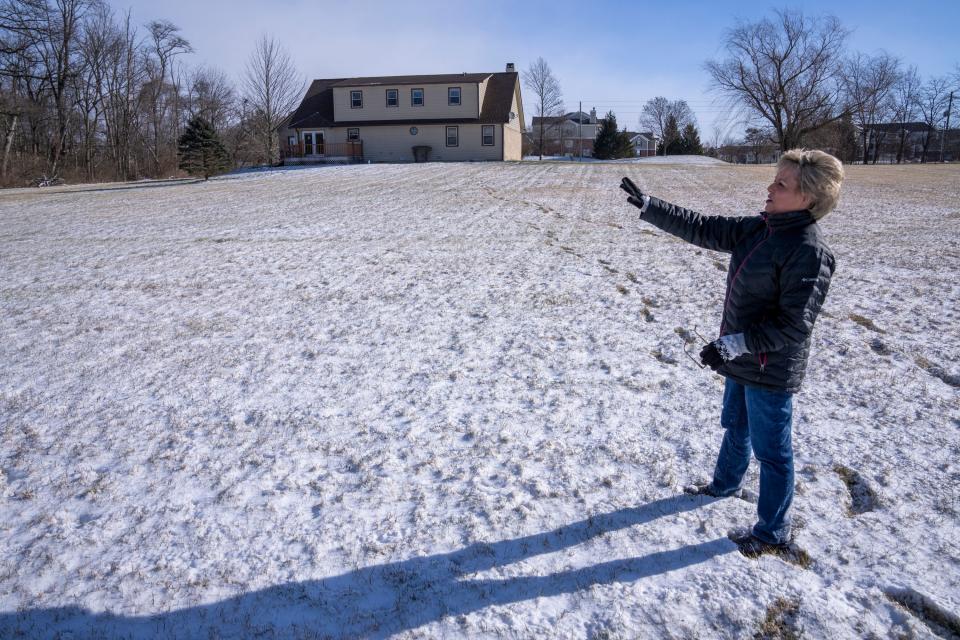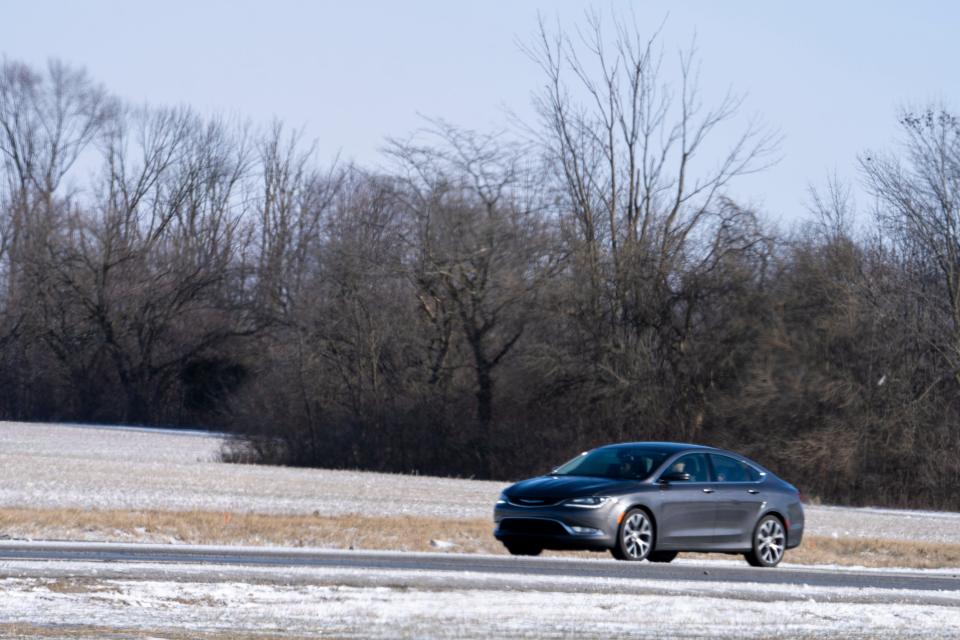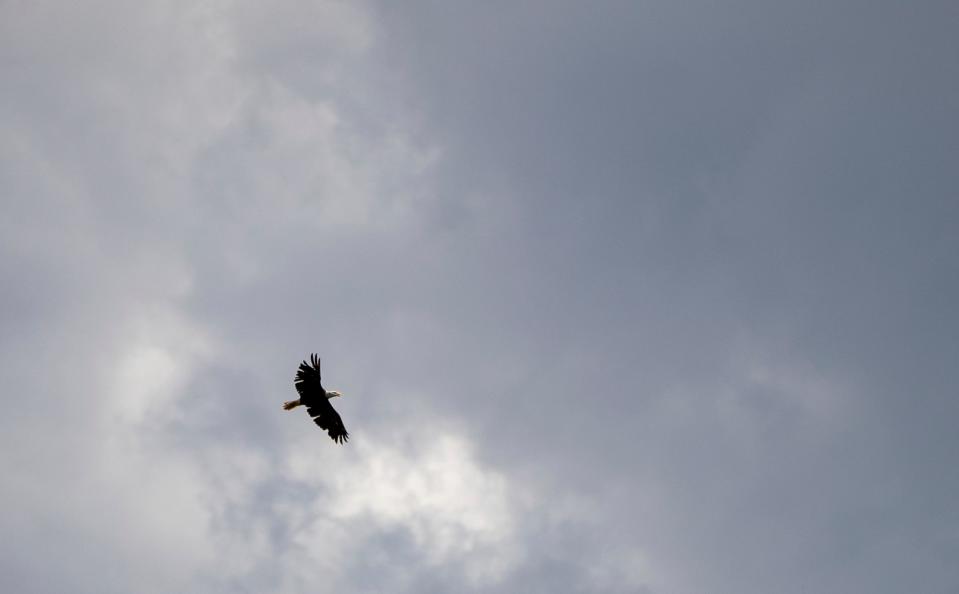'It's heartbreaking': Proposed warehouse development would destroy Marion County wetlands
For environmental advocates, it’s deja vu: Another wetland, another development, another loss.
This time, the target is in Franklin Township along I-65 on Indianapolis’ southside.
A warehouse development just off the highway would directly impact almost 30 acres of wetlands, including some of the rarest and highest-quality wetlands in Indiana. They will be destroyed.
Much more than that stands to be harmed in the process. Robin Heldman has lived next to the proposed development for 24 years, yet she still never grows tired of the wildlife she sees on an almost daily basis. Red-tailed hawks, bald eagles, blue herons, white egrets, migrating waterfowl and even sandhill cranes. They have great horned owls and woodpeckers. Just last week Heldman and her husband saw four 10-point bucks out their backyard.
“There is just a plethora of different kinds of wildlife in the area and I enjoy all of it,” Heldman said. “But now every time I look out my back door, my heart sinks to think I will look out and see a huge massive warehouse. It’s heartbreaking.”

Wetlands: In bill gutting wetland protection, lawmakers agreed to a study. It found new law harmful.
Currently the area is a couple hundred acres of agricultural land dotted with wetlands and wooded areas. But Gershman Partners is proposing a large retail development that will include several large warehouses.
There are about 45 acres of wetlands across the development site, and nearly two-thirds of them will be directly impacted by the buildings. Less than four acres of those wetlands, however, will be regulated. That means less than 15% of the impacted wetlands will be protected in any way, according to the Hoosier Environmental Council, an environmental group advocating against the project.
The rest will be filled in and paved over.
Gershman Partners did not respond to IndyStar’s request for comment.
Wetlands have been under attack across the state and country recently. Indiana laws have stripped protections and a federal Supreme Court decision left further wetlands unguarded. Hundreds of acres of wetlands have been lost across the state in just the last two years.
Their loss is not just concerning for their beauty and wildlife, according to Susie McGovern, the senior water policy associate at the Hoosier Environmental Council. Wetlands are critical for storing water to prevent flooding, recharging Indiana’s groundwater supplies and filtering the water on its way.
Pushback against this development first began nearly two years ago, and has only grown in that time. The project is now awaiting its final permit approval from the state’s environmental agency. More than 2,000 people across Indiana signed onto a letter submitted by HEC to the Indiana Department of Environmental Management opposing that permit.
“That goes to show that a lot of people really care about wetlands … and wanted to sign the letter,” McGovern said. “I think it speaks to the fact that the people in Indiana are wanting to see wetlands be protected.”

Goes against the strategic plan
Heldman first became involved in 2022, when this project was before the city’s Metropolitan Development Commission for the land to be rezoned to allow for the development.
Gershman, an Indianapolis-based company, as well as Citimark Management Co., plan to build a $174-million retail area near the intersection of County Line Road and Arlington Avenue. It will have five warehouses as well as two areas to lease to retailers and a possible hotel site.
Heldman as well as McGovern from HEC spoke at a hearing about the rezoning, raising several questions and concerns — the main one being the proposed development contradicts the strategic plan for the I-65 corridor in that area.
Heldman remembers attending some meetings back in 2008 when that plan was being formed, and was pleasantly surprised. In many ways, McGovern added, the strategic plan is very protective of wetlands and other natural areas. It calls for creative development to help enhance and preserve the natural resources and assets on the land, such as wetlands.
“But from the get-go, I said this is a cookie-cutter development and no creativity,” Heldman said. “If you drive down the highway just a few miles, there are a bunch of warehouses and if you keep driving there are even more. This one doesn’t look any different and doesn’t propose to be any different.”
The developers plan to install 300 trees and more than 1,200 shrubs under their current plans. They also are proposing to protect around five acres of wetlands. But environmental advocates argue that’s not enough. The wetlands and shrubs will be completely surrounded by development and isolated from other natural systems, and therefore won’t be helpful for wildlife or significant stormwater storage.
“They are putting in a tremendous amount of concrete in a natural area and those trees and shrubs are not going to replenish what they are destroying,” Heldman said. “It is not going to replace the ecosystem that’s already there.”
Despite raising these concerns, the rezoning was approved unanimously and with little discussion. Attempts to reach the Department of Metropolitan Development were unsuccessful.
McGovern said the commissioners cited the need for industrial development. However, more warehouse space is sitting empty across the U.S. than at any time since the pandemic. The vacancy rate jumped to 5.2% at the end of last year — up from 3.1% the previous year — according to a new report from commercial real-estate services firm Cushman & Wakefield.
Much of the current warehouse space in the pipeline is being built as speculative projects without tenants lined up, the report said. No tenant was identified for the Franklin Township development when first prepared, and it is unclear if there is a tenant at this time.

Mitigation concerns
Of the nearly 30 acres of wetlands that would be directly impacted, only about four of those acres would be regulated. That means the developer needs a permit from Indiana’s environmental agency to build in these wetlands.
The developer has already received permit approval for nearly three acres and is awaiting a final decision on its permit for the remaining amount.
With that permit approval, those lost wetland acres must be mitigated, which means new wetlands must be constructed elsewhere to compensate for the losses. While mitigation is better than nothing, advocates say, it still is not as beneficial as preserving existing wetlands.
While the newly created wetlands are meant to be in the same watershed, that still doesn’t provide the same benefits lost in that particular spot, such as stormwater storage. One acre of wetlands can store as many as 1.5 million gallons of water per acre, according to the U.S. Environmental Protection Agency.
Heldman said her family has never experienced flooding in more than two-decades in their home, “but what would this do to that?” she wonders.
Their house has both a septic system and a well, and she worries she could have issues with both. If water isn’t soaking into the ground from the wetlands anymore, the groundwater level could drop below her well and the surface would experience flooding.
Most companies don’t do the mitigation themselves, but rather pay for mitigation credits for the Indiana Department of Natural Resources to complete on their behalf. Gershman Partners is buying credits to mitigate the roughly four acres of impacted Class III wetlands, or the highest-quality wetlands in the state.
However, the state program is not without its challenges. U.S. Army Corps of Engineers rules require DNR to begin construction of replacement wetlands within three years of the mitigation credits being purchased. But sales of mitigation credits have far exceeded the agency’s expectations, according to a recent DNR annual report.
The Upper White Service Area — the area where the credits for the Franklin Township development will be built — in particular is in high demand. As a result, DNR is not able to keep up and doesn’t have enough time to plant all the new wetlands. It also is struggling to find appropriate land for the wetlands.
Heldman said that is a major concern for her and a flaw in the process that needs to be addressed. She’d like to see that addressed by the state’s leaders.

Protections stripped away
That said, in recent years policy across the state has moved away from preserving wetlands.
In 2021, the Indiana legislature passed a bill that stripped protections for most wetlands across the state, leaving some protections only for those highest-quality class III wetlands. Other wetlands — those considered class I and class II — no longer require any sort of mitigation.
Before that time, Indiana actually had one of the more protective wetlands laws across the country. Developers were required to apply for and receive a permit to build on nearly any type of wetland across the state. However, the Indiana Builders Association led a push to repeal that law, arguing it was needed to remove red tape for developers and builders.
“When we look at where this fits into the statewide wetland policy context, this [Franklin Township] property is a prime example of what’s happened to wetland protections in recent years,” said Indra Frank, HEC’s director of environmental health and water policy.

“We are now in an era of accelerated wetland loss,” she added, “and this property really illustrates that.”
Before the 2021 change, Indiana already had lost 85% of the wetlands it had a century ago, with many being drained for farming and development. Since then, Indiana has lost close to 350 acres of wetlands, according to a report from HEC. Roughly 90 of those acres were mitigated, but more than 260 acres of wetlands were completely lost — no permit or mitigation was required. In the grand scheme of things, that may not seem like a lot. But think about it in a different way: Indiana has lost the ability to store as much as 400 million gallons of water in just two years.
Water shortage: Water isn't only a Western problem. Here's why some Hoosiers are worried about running out
A 2023 report from the White River Alliance gave Indiana a grade of ‘F’ for wetlands loss.
Even more, a decision from the U.S. Supreme Court last year further removed guardrails around developing wetlands. Essentially, it said it would leave wetlands regulations up to the states. In Indiana, that means few protections.
A task force created out of the 2021 bill to study the status of wetlands found that Indiana needs state-level regulations for preserving wetlands — like the very ones stripped.
Some bills have been proposed since 2021 that would re-establish some of the lost protections, but they have failed to be passed by the super-majority Republican legislature. Another such bill has been proposed this year as the 2024 session gets under way. That bill has been assigned to the House Environmental Affairs Committee, but has yet to be scheduled for a hearing.
As for the Franklin Township development, IDEM accepted public comments about the wetlands permit until Jan. 3. In addition to submitting the letter, the Hoosier Environmental Council has requested a public hearing on the permit and is waiting to hear if that will be granted.
A decision on the final wetlands permit could come anytime in the coming months, and if the project gains a final approval construction — and the destruction of more wetlands — could begin as early as this spring.
Call IndyStar reporter Sarah Bowman at 317-444-6129 or email at sarah.bowman@indystar.com. Follow her on Twitter and Facebook: @IndyStarSarah. Connect with IndyStar’s environmental reporters: Join The Scrub on Facebook.
IndyStar's environmental reporting project is made possible through the generous support of the nonprofit Nina Mason Pulliam Charitable Trust.
This article originally appeared on Indianapolis Star: Residents oppose big warehouse development that would destroy wetlands

